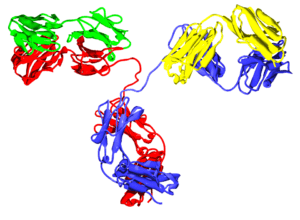
Structure of an IgG2 antibody. Created from PDB 1IGT, PMID 9048542.TimVickers, English Wikipedia, Wikimedia Commons
Chronic viral infection is associated with high viral load which can lead to T cell dysfunction of CD8 and Th1 CD4 T cells. During chronic infection there is a bias towards differentiation of CD4 T cells towards a follicular helper T cell (TFH) phenotype, what role this plays in controlling established chronic infection is unclear.
TFH are CXCR5+PD-1+ T cells that express high levels ICOS, co-stimulatory molecules, CD40L and IL-21. Expression of CXCR5 enables localisation of TFH to the B cell follicles via CXCL13 chemokine, where TFH play a role in T-cell dependent B cell differentiation functions. Functions of TFH cells have been well studied during acute infection and vaccination, where they have been shown to promote survival and differentiation of B cells to long lived plasma or memory B cells that produce high affinity antibodies (Ab).
Murine lymphocytic choriomeningitis virus (LCMV) chronic infection models, have shown that TFH cells are absent during early stages of infection. The absence of TFH is associated with the generation early LCMV-Ab responses that only limit viral spread and are unable to eliminate the viral infection. LCMV-neuatrilising Ab (nAb) are only generated 60-80 days post infection and are responsible for viral clearance.
Researchers aimed to determine whether increased differentiation of CD4 T cells to TFH plays an important role in generation of nAb during chronic infection. Greczmiel et al. showed that TFH and not CD4 T cells are dispensable for the generation of LVMV-specific Ab, where knockdown of Bcl6+ CD4 T cells did not lead to lower levels of LCMV-IgG titres. Despite no effect on LCMV-IgG titres, absence of CXCR5+ TFH resulted in the impaired generation of LCMV-nAb. This finding is in contrast to studies of influenza infection where, TFH were shown to be dispensable for the generation of influenza-specific nAb. Chronic LCMV is associated with viral escape where the virus undergoes mutational adaptations preventing binding of Ab and resulting in viral persistence. Researchers demonstrated that the absence of CXCR5+ TFH results in no neutralisation of mutating viruses. Illustrating that CXCR5+ TFH play a vital in the driving the adaptation of humoral response towards the mutating virus by enabling the generation LCMV-nAb. Only when LCMV-nAb are present does LCMV viral clearance occur.
Thus, Greczmiel et al. showed that though CXCR5+ TFH are not essential for the generation of LCMV-Ab, they are required for the development of LCMV-nAb which enable viral clearance. The exact role of CXCR5+ TFH play in generation nAb is still up for debate. Do they actively send viral-specific B cells through multiple rounds of somatic hypermutation, resulting in the generation of nAb or do they selectively identify B cells with most virus adapted Ab?
Journal Article: Greczmiel et al. 2017. Sustained T follicular helper cell response is essential for control of chronic viral infection. Science Immunology
Journal Article by Cheleka AM Mpande











